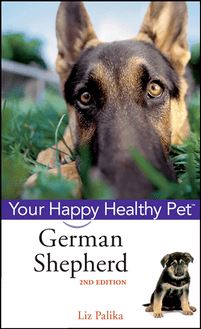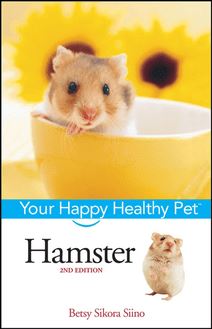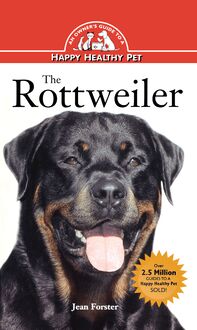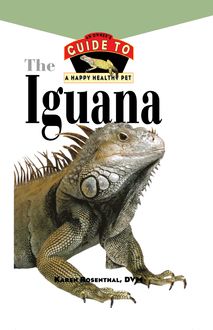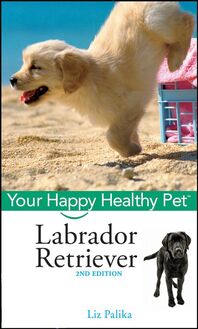Bearded Dragon , livre ebook
95
pages
English
Ebooks
2008
Vous pourrez modifier la taille du texte de cet ouvrage
Obtenez un accès à la bibliothèque pour le consulter en ligne En savoir plus
Découvre YouScribe en t'inscrivant gratuitement
Découvre YouScribe en t'inscrivant gratuitement
95
pages
English
Ebooks
2008
Vous pourrez modifier la taille du texte de cet ouvrage
Obtenez un accès à la bibliothèque pour le consulter en ligne En savoir plus
Publié par
Date de parution
05 février 2008
Nombre de lectures
1
EAN13
9780470209011
Langue
English
Poids de l'ouvrage
4 Mo
Bearded dragons are increasingly popular; they may soon overtake the green iguana as the most popular reptile in the U.S. With their unique appearance, docile nature, and minimal care requirements, beardies make a great introduction to reptile keeping. With colorful photos, charts, and tables, this guide covers the basics, including:
- The beardie's background and the various breeds of bearded dragons
- Choosing your bearded dragon
- Setting up and maintaining your beardie's home, complete with a basking area and lighting
- Feeding and caring for your bearded dragon
Part I: The Wonderful Lizard of Oz.
Chapter 1: What Is the Lizard of Oz?
The Types of Bearded Dragons.
Chapter 2: The Wild Life of the Bearded Dragon.
Temperature Regulation.
Predator and Prey.
Beardie Social Interactions.
Bearded Dragons as Pets.
Courtship and Mating.
Chapter 3: Beardies in and out of Oz.
Australian Wildlife Crises.
How the Bearded Dragon Left Oz.
An Australian Perspective.
Part II: Your Pet Bearded Dragon.
Chapter 4: The Biology of Beardies.
Beardie Anatomy.
Beardie Physiology.
Beardie Senses.
Chapter 5: Choosing a Pet Bearded Dragon.
Bring Home a Healthy Beardie.
Color Variations and Designer Beardies.
Where to Get Your Bearded Dragon.
Chapter 6: Setting Up Your Beardie’s Home.
Indoor Housing.
Lighting the Lizard of Oz.
Providing Heat.
Cage Cleaning and Maintenance.
Outdoor Housing.
Part III: Caring for Your Bearded Dragon.
Chapter 7: Feeding Your Bearded Dragon.
Fruits and Veggies.
Commercial Lizard Foods.
Insects.
Feeding Babies—Newborn to 4 Months Old.
Feeding Adults—4 Months to Adulthood.
Water for Your Beardies.
Chapter 8: Keeping Your Beardie Healthy.
Choosing a Veterinarian.
Hereditary Diseases.
Nutritional Disorders.
Traumatic Injuries.
Infectious Diseases.
Parasitic Infections.
Handling Do’s and Don’ts.
Dystocia.
Neurological Disorders.
Environmental Toxins.
Brumation.
Chapter 9: Breeding Bearded Dragons.
Sexing.
Conditioning and Nutrition.
Getting to Know You.
Egg Laying.
Incubating Bearded Dragon Eggs.
Hatching Eggs.
Baby Dragons.
Appendix: Learning More About Your Bearded Dragon.
Some Good Books.
Magazines.
Internet Resources.
Reptile Veterinarians.
Shows, Expos, and Swap Meets.
Shopping on the Internet.
Index.
Publié par
Date de parution
05 février 2008
Nombre de lectures
1
EAN13
9780470209011
Langue
English
Poids de l'ouvrage
4 Mo
This book is printed on acid-free paper.
Copyright © 2008 by Wiley Publishing, Inc., Hoboken, New Jersey. All rights reserved.
Howell Book House
Published by Wiley Publishing, Inc., Hoboken, New Jersey
No part of this publication may be reproduced, stored in a retrieval system or transmitted in any form or by any means, electronic, mechanical, photocopying, recording, scanning or otherwise, except as permitted under Sections 107 or 108 of the 1976 United States Copyright Act, without either the prior written permission of the Publisher, or authorization through payment of the appropriate per-copy fee to the Copyright Clearance Center, 222 Rosewood Drive, Danvers, MA 01923, (978) 750-8400, fax (978) 646-8600, or on the web at www.copyright.com. Requests to the Publisher for permission should be addressed to the Legal Department, Wiley Publishing, Inc., 10475 Crosspoint Blvd., Indianapolis, IN 46256, (317) 572-3447, fax (317) 572-4355, or online at http://www.wiley.com/go/permissions.
Wiley, the Wiley logo, Howell Book House, the Howell Book House logo, Your Happy Healthy Pet, and related trade dress are trademarks or registered trademarks of John Wiley & Sons, Inc. and/or its affiliates in the United States and other countries, and may not be used without written permission. All other trademarks are the property of their respective owners. Wiley Publishing, Inc. is not associated with any product or vendor mentioned in this book.
The publisher and the author make no representations or warranties with respect to the accuracy or completeness of the contents of this work and specifically disclaim all warranties, including without limitation warranties of fitness for a particular purpose. No warranty may be created or extended by sales or promotional materials. The advice and strategies contained herein may not be suitable for every situation. This work is sold with the understanding that the publisher is not engaged in rendering legal, accounting, or other professional services. If professional assistance is required, the services of a competent professional person should be sought. Neither the publisher nor the author shall be liable for damages arising here from. The fact that an organization or Website is referred to in this work as a citation and/or a potential source of further information does not mean that the author or the publisher endorses the information the organization or Website may provide or recommendations it may make. Further, readers should be aware that Internet Websites listed in this work may have changed or disappeared between when this work was written and when it is read.
For general information on our other products and services or to obtain technical support please contact our Customer Care Department within the U.S. at (800) 762-2974, outside the U.S. at (317) 572-3993 or fax (317) 572-4002.
Library of Congress Cataloging - in - Publication Data:
Grenard, Steve.
Bearded dragon / Steve Grenard.—2nd ed.
p. cm.—(Your happy healthy pet)
Includes index.
ISBN-13: 978-0-470-16511-9 (cloth)
ISBN-10: 0-470-16511-1
1. Bearded dragons (Reptiles) as pets. I. Title.
SF459.L5G755 2007
639.3'955—c22
2007020117
Printed in the United States of America
10 9 8 7 6 5 4 3 2 1
Book design by Melissa Auciello-Brogan
Cover design by Michael J. Freeland
Book production by Wiley Publishing, Inc. Composition Services
Wiley Bicentennial Logo: Richard J. Pacifico
About the Author
Steve Grenard is an avid herpetologist with more than forty years of experience with amphibians and reptiles; he published a paper on the reproduction of the Marsupial Frog in 1958. In the summer of 2000, he published a controversial and widely debated review in Natural History Magazine on the possibility of American rattlesnake venoms evolving new properties. He is the author of several Howell Book House titles, including: Your Happy Healthy Pet: Frogs and Toads, An Owner’s Guide to a Happy Healthy Pet: Lizard and Amphibians: Their Care and Keeping . He is also the author of a number of scholarly medical and herpetological books, including Medical Herpetology and Handbook of Alligators and Crocodiles , and is the author of Introduction to Respiratory Care , a best-selling text review of respiratory therapy. Steve is a board-certified respiratory therapist and polysomnographer and is the clinical coordinator of the Institute of Sleep Medicine at Staten Island University Hospital in Staten Island, New York.
About Howell Book House
Since 1961, Howell Book House has been America’s premier publisher of pet books. We’re dedicated to companion animals and the people who love them, and our books reflect that commitment. Our stable of authors—training experts, veterinarians, breeders, and other authorities—is second to none. And we’ve won more Maxwell Awards from the Dog Writers Association of America than any other publisher.
As we head toward the half-century mark, we’re more committed than ever to providing new and innovative books, along with the classics our readers have grown to love. From bringing home a new puppy to competing in advanced equestrian events, Howell has the titles that keep animal lovers coming back again and again.
Contents
Part I: The Wonderful Lizard of Oz
Chapter 1: What Is the Lizard of Oz?
The Types of Bearded Dragons
Chapter 2: The Wild Life of the Bearded Dragon
Temperature Regulation
Predator and Prey
Beardie Social Interactions
Bearded Dragons as Pets
Courtship and Mating
Chapter 3: Beardies in and out of Oz
Australian Wildlife Crises
How the Bearded Dragon Left Oz
An Australian Perspective
Part II: Your Pet Bearded Dragon
Chapter 4: The Biology of Beardies
Beardie Anatomy
Beardie Physiology
Beardie Senses
Chapter 5: Choosing a Pet Bearded Dragon
Bring Home a Healthy Beardie
Color Variations and Designer Beardies
Where to Get Your Bearded Dragon
Chapter 6: Setting Up Your Beardie’s Home
Indoor Housing
Lighting the Lizard of Oz
Providing Heat
Cage Cleaning and Maintenance
Outdoor Housing
Part III: Caring for Your Bearded Dragon
Chapter 7: Feeding Your Bearded Dragon
Fruits and Veggies
Commercial Lizard Foods
Insects
Feeding Babies—Newborn to 4 Months Old
Feeding Adults—4 Months to Adulthood
Water for Your Beardies
Chapter 8: Keeping Your Beardie Healthy
Choosing a Veterinarian
Hereditary Diseases
Nutritional Disorders
Traumatic Injuries
Infectious Diseases
Parasitic Infections
Handling Do’s and Don’ts
Dystocia
Neurological Disorders
Environmental Toxins
Brumation
Chapter 9: Breeding Bearded Dragons
Sexing
Conditioning and Nutrition
Getting to Know You
Egg Laying
Incubating Bearded Dragon Eggs
Hatching Eggs
Baby Dragons
Appendix: Learning More About Your Bearded Dragon
Some Good Books
Magazines
Internet Resources
Reptile Veterinarians
Shows, Expos, and Swap Meets
Shopping on the Internet
Index
The Bearded Dragon
Chapter 1
What Is the Lizard of Oz?
A ccording to legend, it all began with the bottom drawer of a filing cabinet. Lyman Frank Baum, some eight days short of his 42nd birthday, was sitting with his family and their children’s friends on the evening of May 7, 1898, when the wizard of Oz was invented. Baum was entertaining the children with a fairy tale about some fantastic characters when one little girl, beside herself with curiosity, asked, “Oh please, Mr. Baum, where do they live?”
Baum, stuck for an answer, glanced around the room and caught a glimpse of a two drawer filing cabinet over in the corner. The top drawer was labeled A–N and the one down under, O–Z.
But Oz was not only a magical place in Baum’s fruitful imagination. It’s also the nickname Australians use for their country. They say it comes from a different source, though: When Australians say “Aussie,” it sounds like “Ozzie.”
Still, Baum’s Oz was truly a magical, wonderful place filled with many improbable creatures. And, remarkably, one could say the same thing about Australia. The amazing reptiles (and marsupials) of Australia exist not somewhere over the rainbow, but only down under in Oz.
Bearded dragons are members of the lizard family Agamidae. The lizards in this very diverse family (there are more than 350 species!) are known by a variety of common names, including chisel-toothed lizards, dragons, and pricklenapes. Some have more terrifying but unjustified monikers, such as bloodsuckers and thorny devils ( Moloch horridus ). They are found in Asia, Africa, Europe, the Middle East, and, of course, in Australia. They have large mouths and a distinctive-shape head that is adorned with spikes and thornlike structures that look like the thorns on a rosebush. Agamids have well-developed limbs and can move quickly. Unlike some other lizards, most agamids are unable to move their tails independently of their bodies. After looking at various kinds of agamids, you will soon be able to discern the family resemblance among them.
The bearded dragons were originally assigned to the genus Amphibolurus , a name derived from the Greek that means “a tail that can be lashed this way and that.” This name refers to a group of agamid lizards with long, thin, whiplike tails. But it soon became evident that beardies were different from the other lizards in this genus. For one thing, they have shorter tails, and they wag them. Plus, there’s the beard. And so, in 1982, an Australian zoologist placed these unique lizards in their own genus, which he named Pogona , from the Greek pogon , which means “beard.”
By this time, the question on everyone’s mind is: Do these lizards really have beards? The answer is no . . . at least, not hairy ones. No reptiles have hair. Beardies have a highly distensible throat (called the gular pouch), which is covered on the outside by filamentous floppy processes (flappy sprigs of scale tissue that resemble a beard) emanating from their scales. As





